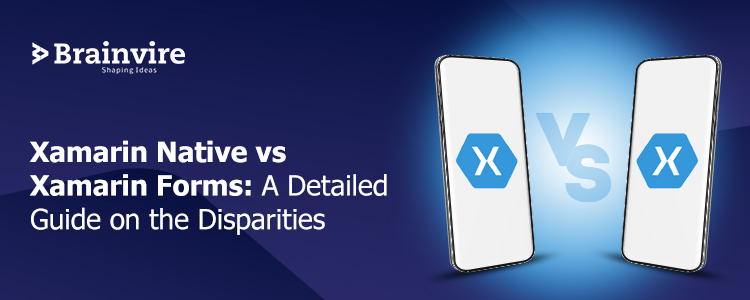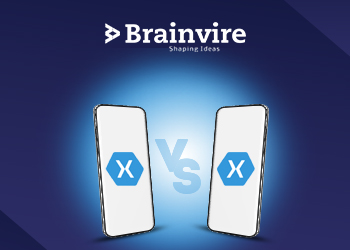
While building a smartphone application, the most basic point to ponder upon is the platform you are aiming for. This is followed up by the decision-making of which stack to follow for the development process.
For new businesses in the line, the entire process might seem a little daunting. To help you better, we are here with some prominent disparities between Xamarin Native and Xamarin Forms. Both have their own set of positives and drawbacks, so check which one fits the best.
What Exactly is Xamarin?
Businesses already in the development industry would know what Xamarin is. However, the term may be a little daunting for startups. So, let’s address the basic insight into Xamarin.
Xamarin is an open-source platform by Microsoft for creating Android and iOS applications with .NET and C#. It started in 2011 with Mono for Monotouch and Android.
Xamarin provides a .NET framework with defined libraries for macOS, Android, iOS, and others. It promotes developers to share an average of 90% of the app across platforms. This pattern enables developers to form an app using a single language with the performance and look of native development.
With Xamarin, the entire application is built on C# and the backend code and business logic are fully shareable. They also have full access to the underlying platform.
Xamarin Native
Xamarin.iOS and Xamarin.Android are often quoted as Xamarin traditional or Xamarin. Native.
This cross-platform toolkit enables developers to build mobile apps using the .Net framework and C#. In the Xamarin native app, the platform code is stored either in a shared project or PCL ( Portable Class Library). Tools, like Xamarin.Android, Xamarin.iOS, Xamarin.Mac, help in the implementation of native user experience and platform-specific functionalities.
Xamarin.Forms
This is the refined version of Xamarin.Native that allows single XAML to be employed to target various platforms in one go. The features of Xamarin are inherited by the application built with Xamarin.Forms. With the help of Xamarin.Forms, app developers can put down business logic in C# and the User Interface can either be stipulated in XAML format or code to make the code shareable across multiple platforms.
Major Disparities Between Xamarin Native and Xamarin Forms
According to the Xamarin website, Xamarin.Forms can share nearly 100% of the app across platforms. However, with Xamarin.Native, the average comes down to 75%.
Xamarin.iOS and Xamarin.Android both are built with an open-source edition of the .NET framework, Mono. To develop these applications, you need to use C# and there is a chance to share-up to 75% of the app across platforms.
With Xamarin traditional approach, developers can use C# programming language to write models and more. So developers are writing the code logic once and can share it between Xamarin.iOS and Xamarin.Android projects. For separate projects, they need to write platform-specific code for the platform and have access to their APIs.
As per Xamarin website, “Anything that you do in Java, Objective-C, or Swift can be performed in C# with Xamarin by using Visual studio.”
Project Structure of Xamarin.Native
- Shared code project: Codebase that is reusable and basic for other projects
- Xamarin.Android: Android app project where developers write code using Android-specific APIs
- Xamarin.iOS: Project for the iOS application where developers write code using iOS- specified APIs
Xamarin.Forms framework enables developers to rapidly build cross-platform UI. It offers its own inference for the user interface that will be induced by using native restraints on Android, iOS, and Windows. To be clear, this means that the app can share a huge portion of user interface code and can possess the native features and functionalities.
With Xamarin.Forms framework, you can write your user interface code using XAML or C# with the opportunity to employ MVVM.
Xamarin.Forms Have a Simple Project Structure
- Shared code project: Keeps the common code base and you can also write code for UI, as you are using Xamarin.Forms
- Xamarin.Android and Xamarin.iOS: Code for the specific platform and Custom renderers and dependency services
Reasons to Choose Xamarin Native and Xamarin Forms
Xamarin is the gold-standard when it comes to cross-platform tools. However, when you have decided to go for Xamarin, you need to decide on which one to choose – Xamarin.Forms or Xamarin.Native? Take a look at a few reasons for each development tool to ease your decision-making.
Xamarin.Forms
- Restricted Budget
Budget is the most common topic while discussing app development. If your business case for app MVP, it will demand launch on both iOS and Android platforms. Saving development cost is of utmost importance. So choose Xamarin.Forms if the budget is tight.
- Apps Must Be Simple to Update
One of the most overrated benefits of Xamarin.Forms is that by coding once, you can simplify the process of maintaining and updating the application. As the UI is shared easily in Xamarin.Forms, the features are also updated easily in both iOS and Android.
- Quick Launch in the Market
Whether you are working for a company or developing an application internally, the efficiency quotient of Xamarin helps in launching the app faster in the market. By using Xamarin.Forms to share code and UI, your project will move twice the normal speed.
Xamarin.Native
- App Size Needs to Be Small
Xamarin.Forms lead to bigger app size. This simply means the loading of such an application will take a long time specifically in Android. So, if you want your app to load at lightning speed go for Xamarin.Native.
- App Has a Lot of Complex UI or Animation
If your app contains a lot of animation, you will need native development to improve the performance. Dynamic contents might better suit an application that is coded in C# with Xamarin but is designed on the Xamarin.iOS and Xamarin.Android.
Conclusion
Make sure that you stick to what you have planned, like a single platform for both tablets and mobiles or one for each. Make the preference according to your present and future needs. While opting for a development stack, keep the over-engineer part aside but don’t go for the option that can obstruct the code-sharing feature in the future.
Related Articles
-
Mobile Apps & Technology – The Best Tools for Retailers to Thrive in Ecommerce World
In the present internet savvy world, buying has become an online activity as more and more people tend to buy products from online stores. Buying from online stores not only
-
Advance Programming Language for Developing iOS Apps [Detailed Guide]
Do you have an iOS app project underway? It is imperative to be aware of the several development choices at your disposal. And if you’re keen to create iOS mobile
-
How To Get Started With On Demand App Services
Talking About How To Get Started With On Demand App Services, There are mobile app develpement companies that offer on-demand services at customer’s conditions. They are always looking forward to



